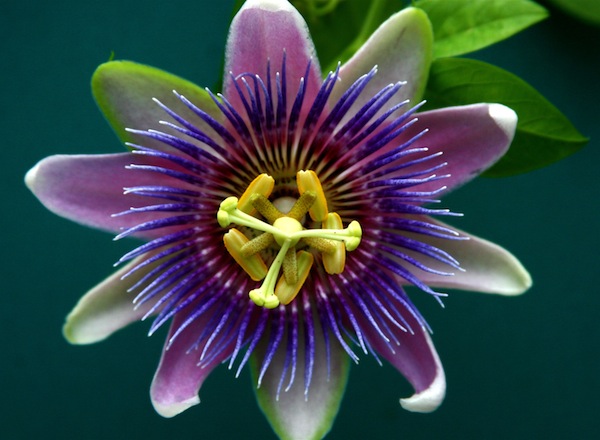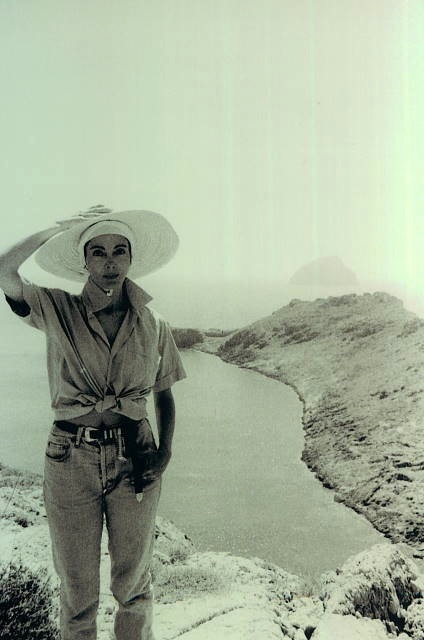Scent & Sensibility: The Passion Flower

“Long ago, the day before my-then-fiancé, Kevin Andrews, drowned before my eyes off the Greek island of Kythira, I was walking up a cobbled path in the island’s main town of Hora, when an immense passion flower presented itself to me, in full bloom, its tendrils extended like violet lashes and, Reader, like Ensifera ensifera, I plunged my tiny beak into its sweet core.” Elizabeth Boleman-Herring
Ruminant With A View
By Elizabeth Boleman-Herring

“No sooner had the warm liquid mixed with the crumbs touched my palate than a shudder ran through me and I stopped, intent upon the extraordinary thing that was happening to me. An exquisite pleasure had invaded my senses, something isolated, detached, with no suggestion of its origin. And at once the vicissitudes of life had become indifferent to me, its disasters innocuous, its brevity illusory—this new sensation having had on me the effect which love has of filling me with a precious essence; or rather this essence was not in me; it was me . . . Whence did it come? What did it mean? How could I seize and apprehend it? . . . And suddenly the memory revealed itself. The taste was that of the little piece of Madeleine . . .”—Marcel Proust, Remembrance of Things Past
“Often, even after years, mental states once present in consciousness return to it with apparent spontaneity and without any act of the will; that is, they are reproduced involuntarily. Here, also, in the majority of cases we at once recognize the returned mental state as one that has already been experienced; that is, we remember it. Under certain conditions, however, this accompanying consciousness is lacking, and we know only indirectly that the ‘now’ must be identical with the ‘then’; yet we receive in this way a no less valid proof for its existence during the intervening time.”—Hermann Ebbinghaus
 TEANECK New Jersey—(Weekly Hubris)—6/10/2013—It comes as no surprise to me that the Sword-billed Hummingbird (Ensifera ensifera), with its immensely elongated bill, has co-evolved with certain passion flowers, such as P. mixta; nor that Yellow Passion Flower (P. lutea) pollen is apparently the only pollen eaten by the unusual bee Anthemurgus passiflorae [http://en.wikipedia.org/wiki/Passiflora].
TEANECK New Jersey—(Weekly Hubris)—6/10/2013—It comes as no surprise to me that the Sword-billed Hummingbird (Ensifera ensifera), with its immensely elongated bill, has co-evolved with certain passion flowers, such as P. mixta; nor that Yellow Passion Flower (P. lutea) pollen is apparently the only pollen eaten by the unusual bee Anthemurgus passiflorae [http://en.wikipedia.org/wiki/Passiflora].
No surprise at all.
Long ago, the day before my-then-fiancé, Kevin Andrews, drowned before my eyes off the Greek island of Kythira, I was walking up a cobbled path in the island’s main town of Hora, when an immense passion flower presented itself to me, in full bloom, its tendrils extended like violet lashes and, Reader, like Ensifera ensifera, I plunged my tiny beak into its sweet core.
The scent was, and is still, beyond my powers of description.
The experience—the scent—imprinted somewhere deep in my physical brain as an utterly distinct and separate-from-time event. An entire gestalt. A universe. Something beyond the boundaries and limits we usually impose upon experience. I was smitten, possessed, swooning. As I drew back my face, and returned to my still-living partner, the man I loved, a fellow writer, I had no words to describe it. Gently, I pulled his face to the flower, and we spoke. Whatever we said at that moment does not remain in memory, however. Compared to the scent itself, words—any words—would have been the crudest of correlatives.

Marcel Proust, who coined the term “involuntary memory,” and who first expanded upon the concept when he related what biting into a French biscuit known as a Madeleine did to him, willy-nilly, whenever he tasted one, would understand my passion for the Passifloraceae.
For me, for the rest of my life as a sentient being, the humble Greek passion flower will stand in for Proust’s Madeleine. From that tiny, shared-with-one-other sensory moment on Kythira, till today, the scent of a flower will always take me back to September of 1989, when I first discovered it; and it will evoke, forever, every detail of the events that came just after that moment on the path.
The German psychologist Hermann Ebbingham has described what happens in the brain when a scent, or taste, or word fragment—I suppose it can be any laid-down bit of memory at all—becomes linked to or stands in for a host of other experiences. I do not think of this phenomenon as being anything as simple or knee-jerk as Pavlov’s bell [http://en.wikipedia.org/wiki/Ivan_Pavlov]. Nor, is the scent of my passion flower, though it became inextricably linked (arms within arms within arms) to tragedy and loss, part and parcel of Post Traumatic Stress Disorder, though Kevin’s drowning did indeed induce that sensitivity in me.
No. It embodied (Really: it gave a body to) a sort of benison. It was one of Nature’s small and profound and humbling un-sought blessings. The scent is sweet, salty, overwhelmingly erotic, thunderously earthy, a sharp shaft of desire.
It is the whole ball of wax.
Interestingly and, who knows, perhaps the scent also has something to do with this, “Passion Flowers” derive their name from The Passion of Christ.
From Wikipedia: “In the 15th and 16th centuries, Spanish Christian missionaries adopted the unique physical structures of this plant, particularly the numbers of its various flower parts, as symbols of the last days of Jesus and, especially, his crucifixion: The pointed tips of the leaves were taken to represent the Holy Lance; the tendrils represent the whips used in the flagellation of Christ; the ten petals and sepals represent the ten faithful apostles (excluding St. Peter the denier and Judas Iscariot the betrayer).
“The flower’s radial filaments, which can number more than a hundred and vary from flower to flower, represent the crown of thorns; the chalice-shaped ovary with its receptacle represents a hammer or the Holy Grail; the three stigmas represent the three nails, and the five anthers below them the five wounds (four by the nails and one by the lance).
“The blue and white colors of many species’ flowers represent Heaven and Purity.”
“The flower has been given names related to this symbolism throughout Europe since that time. In Spain, it is known as espina de Cristo (“Christ’s thorn”). Older Germanic names include Christus-Krone (“Christ’s crown”), Christus-Strauss (“Christ’s bouquet”), Dorn-Krone (“crown of thorns”), Jesus-Lijden (“Jesus’s passion”), Marter (“passion”) or Muttergottes-Stern (“Mother of God’s star”).”
A lot of baggage for a little flower to carry but, then, I have invested just its scent with my own great passion and the violent loss of a lover.
Oddly enough, going back to the book that I wrote about Kevin’s death off Kythira, 15 years after the event, I find I make no mention of the passion flower, and today is the first time I have written about its significance in my life [http://www.greeceinprint.com/GiPProducts.nsf/publicBook/EE42A2E41EDB03D7852570D6003C4AE9?OpenDocument&ViewLink=&DocType=Book&PLang=all&PGroup=&Tab=2&End=&CartID=15139-062645].
I find, as a writer, that those things closest to the bone are what we hide best even from ourselves . . . until it is almost too late to speak of them. Garrison Keillor—not one of my favorite people, but one hell of a writer—states: “You get old and you realize there are no answers, just stories . . .” But the stories may be like long-locked, dusty, darkened rooms, which we can access, in old age, only via the magical and tiny key of a Madeleine once again on our lips; a Greek passion flower blossom, once again opening itself, ripe and redolent, beneath our nostrils.
Whenever I catch that scent, I am once again a 38-year-old beauty, tan and lithe and loved, not yet battered by the cruel vicissitudes yet to befall me; a little muted by passion and amazement; skin warmed by the autumn sun of the Cyclades; happy; standing apart from reality by several standard deviations; madly in love.
I do not “remember” that woman. I do not “remember” that day. I am that woman; it is again that day.
“Involuntary memory” is such a banal descriptor for such exalted transport. Indeed, it is no descriptor at all. The scent of the Passifloraceae is, for me, as immense as what felled Saul on the road to Damascus.
It remains, for me, a tiny worm hole into a time outside time; where all is well, and all manner of things shall be well, to paraphrase Julian of Norwich [http://en.wikipedia.org/wiki/Julian_of_Norwich].
A portal which I can enter, and disappear through, again and again and again, whenever I am in Greece, in summer or fall, and the passion flowers are in bloom.

12 Comments
Burt Kempner
What an enchanting story.
eboleman-herring
Thank you, Burt. I’m immensely grateful to be able to write again. It’s been a long “silencing.” I’m trying, as well, now, to write about these tiny portals into life; just the smallest of experiences which open up onto (sometimes) vast vistas. The pinhole camera effect you practice so very, very well.
Laura
Beautifully written………..
Sweet T
Beautiful! Thanks for taking me to Greece!
eboleman-herring
Laura and Sweet T, thank you, from the heart (the passion flower always in the heart). :-)
Anita Sullivan
You describe so accurately this experience! I always wonder WHERE these parts of oneself “go” when they are dormant, and are they still surreptitiously doing their good work even when you have “forgotten” them? This is a classic piece of writing, I will print it out and savor it again later. Thanks!
eboleman-herring
Anita, you’ve taught me so much about writing over the years I’ve been reading you. I always told writers at The Athenian to “write smaller,” and took decades to learn the lesson, myself. We enter much larger structures through the smallest of doors; through windows, often. Or even keyholes. :-) Love you. e
Virginia
I am left wanting to know more and more………….
eboleman-herring
Thank you, Virginia. I made the first stab at telling this story in a book titled “A Farewell To Ikaros” but, even then, 15yrs after Kevin’s death, it was to soon to write about it: http://www.greeceinprint.com/GiPProducts.nsf/publicBook/EE42A2E41EDB03D7852570D6003C4AE9?OpenDocument&ViewLink=&DocType=Book
JG Gandy
“South Carolina is too small for a republic, but too large for an insane asylum.” – James Louis Petigru of Charleston, South Carolina expressed this unpopular opinion as his native state made the radical decision to secede from the Union in December 1860. Famously the last prominent Unionist in Charleston as the populace embraced secession, Petigru expressed remorse for the death of the Constitution and predicted defeat in the resulting civil war.
Not Pat Conroy’s quote.
Elizabeth Boleman-Herring
Holy Mackerel, JG Gandy! I stand utterly corrected!
larry sherburne
Beautifully written,what an amazing talent!